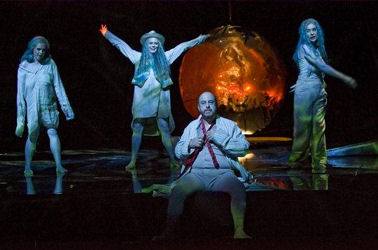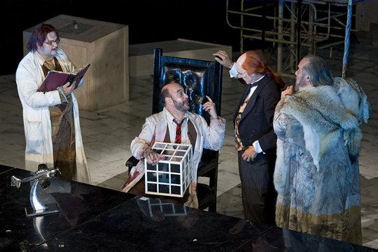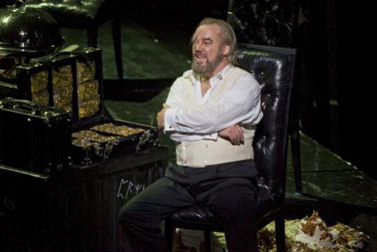Other Links
<Editorial Board
- Editor - Bill Kenny
- London Editor-Melanie Eskenazi
- Founder - Len Mullenger
Google Site Search
SEEN
AND HEARD OPERA REVIEW
Wagner, Das Rheingold:
Soloists, Orchestral of Royal Opera/ Antonio Pappano, Royal Opera
House, London , 17.10. 2007 (MB)
Wellgunde -
Heather
Shipp
Flosshilde
-
Sarah Castle
Alberich - Peter Sidhom
Wotan - John Tomlinson
Loge - Philip Langridge
Fricka - Rosalind Plowright
Freia - Emily Magee
Donner - Peter Coleman-Wright
Froh - Will Hartmann
Fasolt - Franz-Josef Selig
Fafner - Phillip Ens
Mime - Gerhard Siegel
Erda - Jane Henschel
Production:
Stefano
Lazaridis (designer)
Marie-Jeanne
Lecca (costumes)
Wolfgang
Göbbel (lighting)
What a
difference expectations make! When I had last heard Das
Rheingold at
Covent
Garden, it had been at the beginning of the Royal Opera’s
preparations for these complete cycles. Then I had been fortunate
enough, on the occasion before that, to have heard Bernard Haitink
conduct the Ring in semi-staged performances at the Royal
Albert Hall: one of the greatest musical experiences of my life.
To have said that the
Covent
Garden
performance, with much the same cast, broadly the same production,
and the same conductor as the present cycle, had disappointed
would have been to put it mildly. The good news is that things
have improved considerably, doubtless helped by the lowered
expectations, although the improvements remain real and
substantial.
Much of the earlier action worked well too. The first scene, ‘a
complete tragedy in miniature’ (Warren Darcy), told a story, again
far more clearly than before, of Alberich, spurned by the
Rhinemaidens on account of his ugliness, brought to a stage of
frustration at which he would foreswear love in order to win the
Rhinegold. Peter Sidholm’s characterisation of Alberich before the
Fall was most impressive, in that here was an eager, bumbling
dwarf, driven by what Wagner called his liebesgelüste
(‘erotic urge’), not the monstrous tyrant of the third act, nor
the embittered prisoner of the fourth. Indeed, Sidholm
acknowledged all these stages of Alberich’s tragic progression,
with no harm done to more purely musical considerations. The
Rhinemaidens too impressed, perhaps more individually in vocal
terms than when in chorus. But their role as amoral sirens – a
just state of affairs must be created rather than merely
discovered in Nature – was well portrayed. Their movement now
seemed less uncertain. I am not sure that Wotan’s presence,
observing events, added much to our understanding, but nor was it
especially distracting. Much orchestral colour was brought to the
fore, suggesting that Pappano had learned well his lessons as
sometime répétiteur to Daniel Barenboim, whose Wagner has
always exhibited greater colouristic tendencies than his
‘Teutonic’ reputation might allow. Yet there lacked a sense of
true stillness, of a sound that had always been there, with the
crucial opening E flat, the subsequent development of the Prelude
therefore falling somewhat short of the spontaneous generation
that is its lifeblood. Dynamic contrasts were not as great as they
might have been, much of the orchestral direction tending towards
what Pierre Monteux tellingly dubbed the indifference of mezzo
forte. This of all scenes needs more gradations of light and
shade. On the credit side, the music flowed far better than on the
Rheingold’s first outing, in which perennial stops and
starts had prevented the musical melos from ever really
announcing itself.
The crucial transition between the first two scenes, in which the
ring motif metamorphoses into that of Valhalla, showing Alberich
and Wotan to be dialectically related in their pursuit and
acquisition of power, was not heard to best effect. A particularly
jarring moment came with what should have been the magical – in
many senses – first statement of the
Mark Berry Mark Berry's book,
Treacherous bonds and laughing fire- politics and religion in
Wagner's 'Ring' (Aldershot: Ashgate, 2006) is
available from Ashgate Press.
Cast:
Woglinde -
Sarah Fox
Keith Warner
(director)

The Rhinemaidens and Alberich
Talk
about removing the clutter from the production proved to be more
than mere spin. On this occasion, Keith Warner’s vision shone
through far more clearly, less encumbered by the designs than
had previously been the case. We are only at the beginning of the
cycle of course, but it seems that the overarching idea is a good
one, with firm grounding in Wagner’s intentions. Standing with its
intellectual roots in the thought of Ludwig Feuerbach and other
Young Hegelian writers, this Ring bids fair to tell a tale
of supersession of the rule of the gods, first created by men but
subsequently coming to rule over him, by man. The Young Hegelian
critique of religion informed attacks from writers of the
subsequent generation, such as Marx, Bakunin, and Wagner, on other
aspects of the pervading alienation they witnessed, notably with
regard to the state and economics. And so, as the commentator
Peter Wapnewski has written concerning the entry of the gods into
Valhalla,
‘The gods are on dangerous ground, but they fail to recognise the
fact, dazzled as they are by their own splendour, their foolish
arrogance, and their delight in illusions. They are participating
in a glorious, richly costumed dance of death.’ Where before,
confusion had reigned, and it was difficult, even for those of us
who flattered ourselves we ought to know what was going on, to
determine this, a relatively streamlined presentation now aids our
understanding. The final scene’s dance of death is brought out in
all its illusory, deceiving and self-deceiving pomp, whilst Loge,
with his coruscating criticism, detaches himself from his masters
and begins to play with the fire that will consume them and their
fortress of politico-religious deceit. Musically, however, this
discrepancy could have been depicted more strongly, the orchestral
triumph appearing rather unmediated. It was too beautiful,
although the Rhinemaidens’ lament certainly made its point, as had
the mysterious intervention of Jane Henschel’s fine Erda.
Niebelheim

John Tomlinson as Wotan
Thereafter, the music settled down and again was far less subject
to stops and starts than had been the case the first time round.
The gods’ heavenly residence was clearly a place of wealth and
illusion, which is as it should be. The influence, in terms of a
frankly plutocratic portrayal, of Patrice Chéreau’s legendary
Bayreuth
production was no cause for shame; any production of the Ring
must by now come to terms with its predecessors, and will profit
from considering reception history as an integral part of its own
message. The Zeus-Hera relationship of Wotan and Fricka was well
observed. John Tomlinson’s Wotan was as much of a stage presence
as it always has been, and his keen attention to the text and its
implications cannot be commended highly enough. There is sometimes
a more pronounced wobble to his voice than was once the case, but
the dramatic truthfulness is such that this is really only a
matter for pedants. Tomlinson is so immeasurably superior to Bryn
Terfel in the role that the Royal Opera should be thanking its
lucky stars that the latter so gracelessly withdrew at very short
notice. Rosalind Plowright correctly resisted the temptation to
make Fricka too much of a monster: her interest in the ring, once
Loge informs her that it might tie her husband more closely to her
was sharply characterised by a telling shift in vocal quality.
The
prospect of a fine Loge stealing the Rheingold show is
always a distinct possibility. It certainly happened at the
English National Opera, where Thomas Randle was more or less the
only positive aspect of an otherwise execrable production, both
scenically and musically. Here, Tomlinson’s Wotan was far too
strong to cede the stage to Philip Langridge’s quicksilver Loge,
but this was a fine performance. His busy stage action was well
directed by Warner; the combination of this with his vocal
modulation presented a Loge who was, perhaps more than any I have
seen, the very incarnation of instrumental reason. Any tendency
towards caricature was firmly resisted, but he remained an
outsider. The contrast with Franz-Josef Selig’s lovelorn Fasolt,
the only character who truly gains a hold over our emotions in
this frigid world, did credit to both artists. Other parts during
this scene were sung well enough, without any particular insights.
It is, however, worth adding that the insights to be gleaned from
deliberately cipher-like parts such as Freia and Froh are few and
far between. Will Hartmann certainly beguiled in a properly
ineffectual fashion in the latter part, which is probably as much
as one can expect. His pseudo-oriental (Orientalist?) garb was
puzzling, but did no great harm. Phillip Ens’s Fafner, the ‘pure
seeker after power’ (Deryck Cooke) ought really to have been more
imposing, both here and, more crucially, in the final scene.
Nibelheim might be considered more controversial. This is not
straightforwardly the realm of capital as would generally be
understood and certainly as Wagner intended. However, if one takes
a broader view of economic power being a form rather than the
determining form of power – that is, somewhat vulgarly, if one
tends towards Wagner’s proto-Nietzschean will-to-power rather than
to Marxian dialectical materialism – than one can see this
portrayal of a dark world of cruel scientific experiments as far
from entirely out of keeping. This was a development of Wagner
readily comprehensible to students of the post-Freudian Marxism of
the
Frankfurt School, and of Theodor Adorno and Max Horkheimer’s
Dialectic of Enlightenment in particular. It seemed to me to
have much in common with Warner’s fine Covent Garden Wozzeck,
which dwelled on a similar theme. It is certainly one with which
Wagner, and the later Wagner in particular, would have
sympathised, given his increasing hostility towards scientific
domination. For once, the Tarnhelm’s transformations of its wearer
were credible on stage, although, sadly, the Tarnhelm music lacked
the rootless, phantasmagorical mystery, born as much of its
instrumentation as its harmony, which is so vital to full
expression of its seductive horror. Sidholm’s Alberich, as I have
already mentioned, was a man transformed by his new status, and
his interactions with Gerhard Siegel’s creditable Mime, and with
the visitors to Valhalla, were strongly portrayed, as also they
would be during the final scene. If Siegel’s Mime was not a
portrayal that burned itself into the memory, it wisely heeded
Wagner’s warning that Mime must never lapse into caricature, and
paid due attention to musical as well as stage considerations.
The
two other transformation scenes, descending to and ascending from
Nibelheim, lacked somewhat in dramatic impact, although the purely
scenic realisation was well handled. Pappano is not a natural
Wagnerian, but his reading of the score has improved almost out of
recognition. There is still something of a sense of adhering too
much to the leitmotifs as signposts, rather than understanding
leitmotif technique, in Carl Dahlhaus’s words, as ‘the binding
together of a music drama through a dense web of motivic
connections from within’. It was not sufficiently clear that
Wagner’s writing is to a considerable extent symphonic, or at
least post-symphonic, nor that the entire network of interrelated
themes may be seen to derive from the individualisation of, to
quote Wagner himself, ‘a few malleable Nature motifs’. Yet the
dramatic flow was significantly superior, both on stage and in the
pit. Haitink will never, I am sure, be forgotten by those of us
who heard him, but this was, all considered, a better Rheingold
than I had dared hope.
Pictures © Clive Barda
